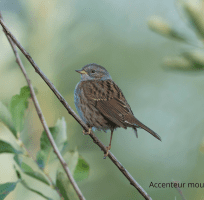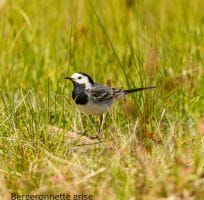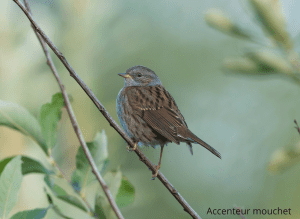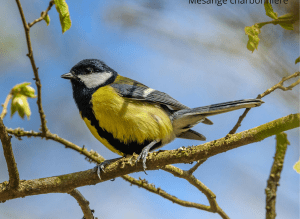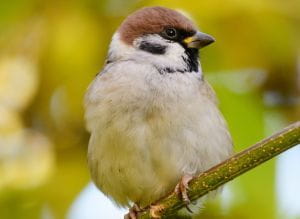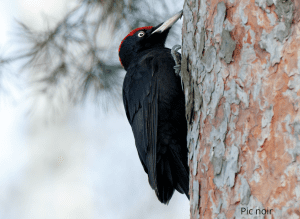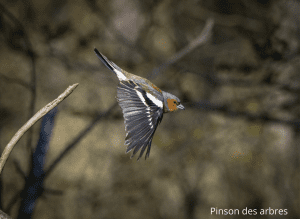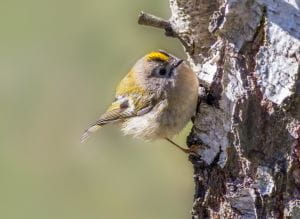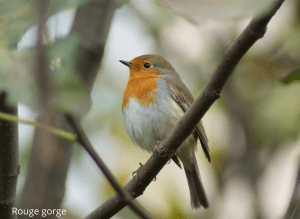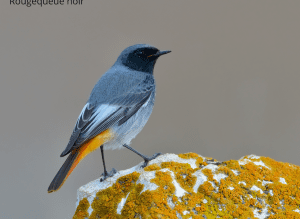The flycatcher
Prunella modularis
Plumage with striped brown upperparts, bluish-gray head and throat, and fine white flecks on the wings, sometimes forming like a wing band.
Fearful by nature,the speckled sandpiper regularly moves under cover of vegetation. When breeding, these birds are known to be polygamous, but practice a rather atypical behavior: knowing the fickle behavior of females, males (in order to ensure their genetic heritage) will peck the female’s cloaca with their beaks, before mating, in order to expel any possible semen from a previous partner.
The Grey Wagtail
Motacilla alba
Slender and graceful in figure, the gray wagtail has a long, narrow black and white tail that it nods at all times. Hence its other name, the hoche-tail.
This is one of the most ubiquitous species! It can be found both on the coast and at altitudes of over 2600m in the Alps. Mainly insectivorous, it can make its home in wetlands, cultivated areas and even cities.
Oak Jay
Garrulus glandarius
Like magpies, the Oak Jay is a great learner. This clever little fellow also enjoys imitating the songs or calls of other species as an anti-predator strategy or to keep other birds away from a food source.
Known for hoarding, this remarkable bird remembers the location of its hiding places, and the period when it stocked up. This allows it to consume its reserves before they rot.
To remove parasites from areas of its body that are too difficult to reach, the jay takes ant baths! He can thus land on an anthill and let the workers clean him, the formic acid acting as a disinfectant for his plumage.
Blue / Chestnut / Great Crested / Nonnette and Black Chickadees
Cyanistes caeruleus, Parus major, Lophophanes cristatus, Poecile palustris and Periparus ater.
Although morphologically similar, tits have different feeding habits, allowing them to share the same habitat with less direct competition for resources.
Blue tits, great tits and great tits are very plastic and can be found in both coniferous and deciduous forests, using different areas in the trees. On the other hand, crested, black and boreal tits are found more frequently in softwood forests.
Chickadees are our best allies against processionary caterpillars. True predators of the last stages of this caterpillar, tits go right into the cocoons to feast on them. A pair of great tits could feed on over 500 caterpillars in the space of 48 hours!
The Blackbird
Turdus merula
The blackbird, now common in our gardens, often sings from dawn to dusk. Males and females are distinguished by plumage and beak color: black with yellow/orange beak for males, light brown plumage dotted with speckles on the breast and brownish beak for females.
The color of the male’s beak, more pronounced than that of the female, is part of a sexual selection phenomenon. During courtship, the male fans out his tail, tucks his head into his shoulders and clearly shows off his beak.
The intensity of the beak’s color, will indicate to the female the efficiency of her partner’s immune system: bright = rich in carotenoids; pale = low in carotenoids and therefore poor immune system quality!
The House Sparrow and Chipping Sparrow
Passer domesticus and Passer montanus
Very common in our gardens and cities, these passerines attract little attention, no doubt because of their numbers and inconspicuous dress. Sparrows are gregarious and quite noisy by nature There are many subspecies whose precise identification can prove difficult.
We will therefore only mention the House Sparrow and the Chipping Sparrow. The latter is distinguished by the presence of a black comma on its cheek. This spot is thought to play a role in nest defense, with the male using it (in a very specific attitude) by frantically moving his head: elongated posture, wings ajar and lowered, and tail raised.
With the house sparrow, the male also defends the future nest site and adopts a similar posture, without putting his head forward.
On La Réserve it is common to observe our male sparrows defending their nest by chasing and pursuing in flight even rock pigeons, though much larger than them.
The Green Woodpecker (Picus viridis), the Black Woodpecker (Dryocopus martius) and the Spotted Woodpecker (Dendrocopos major)
Special case, our woodpecker friends are not passeriformes but pisciformes! On La Réserve we can observe 3 species: the Green Woodpecker, the Black Woodpecker and the Spotted Woodpecker.
The three species are fairly easy to distinguish visually from one another.
The spotted woodpecker is the most common of the woodpeckers with black white and red plumage. The green woodpecker is the best known of all with its characteristic green color and red cap. The black woodpecker meanwhile is the largest of them all with plain black plumage and a red cap. It’s the size of a crow!
These birds are monogamous, and the pairs formed tend to stay in the same territories, digging a new lodge every year. In winter, green woodpeckers are often seen predating on anthills. To do this, they have an extremely long tongue that can extend 10cm beyond the tip of the beak!
The chattering magpie
Pica pica
This gregarious, sedentary, noisy species with remarkable intelligence often comes to make a mess wherever it goes! They dominate small passerines and very often arrive in groups to scoop up food resources!
Although we often try to keep them out of our gardens and vegetable patches, magpies are incredible animals to observe! Their sociality is marked and can be observed daily, as can their intelligence. Some individuals recognize their own reflection as well as the human face, and it’s not uncommon to form bonds with the most inquisitive chatty magpies.
The Tree Chaffinch and the Northern Chaffinch
Fringilla coelebs and Fringilla montifringilla
The tree finch is recognizable by its white double wing band, white/gray tail and rump. For males, the head and chest are red/rusty with a gray cap and nape, but beware its colors are less pronounced outside nuptial periods. Females tend to be confused with house sparrows but can be recognized by a pale patch on the nape.
Northern finches can be distinguished by their often darkly mottled plumage, more orange chest with a black breeding head for males (as well as their chti accent! author’s note)
Tree finches are those whose song is often the best known of all. For a simple reason: the male, to mark his territory and attract a mate, repeats his song over 2,000 times a day!
The Crested and Triple-banded Kinglets
Regulus regulus and Regulus ignicapilla
Wren are Europe’s smallest birds. The male is the smaller of the two, with a yellow stripe edged in black on the cap. The triple-banded kinglet is distinguished by a large white eyebrow underlined by a black eyebrow line, making the head striped. Their colorful crests play a crucial role in courtship displays and territorial defense.
For arachnophobes, the crested kinglet is fond of spiders, as well as insects and a few seeds. However, this little passerine struggles to get through the harshest winters, so it’s not uncommon to see population declines in this species during certain winters. Compensated by abundant reproduction in spring: between 9 and 12 eggs deposited in the nest by the female.
The robin
Erithacus rubecula
This emblematic passerine is one of the most popular in continental Europe. It is known for its aggressive defense of its territory.
The famous orange breast of the red-throat is named after the wrong color, as the word “orange” was not associated with color until the 13th century in France. This brightly colored breast is not related to courtship.
It is an essential element of territorial behavior. The chest-forward postures of the red-throat often enable it to deter competitors and thus avoid combat. Despite this technique 10% of this bird’s mortality is attributed to territorial struggles between males.
The Black Red-tail
Phoenicurus ochruros
Easily recognized from a distance by its upright posture and the constant waving of its orange/red tail. The rest of the plumage can vary from black to gray/brown.The Black Redstart nests in natural or artificial cavities or even in former woodpecker lodges.
Sometimes migratory, sometimes resident, some simply make altitudinal movements before the return of summer.
The torchepot nuthatch
Sitta europaea
The nuthatch nests in tree crevices or former woodpecker lodges. The vernacular name “torchepot” is attributed to it, as it is known to reduce the entrance to its cavity with mud. Like jays, nuthatches have learned to stock up on seeds, which they can store in hiding places or wedge into bark crevices for better hammering.
These small passerines are known for descending from trees upside down. They are easily recognized by their bluish-gray plumage on the back and pale (white or ochre) on the belly, as well as their long, black eyebrow line.
